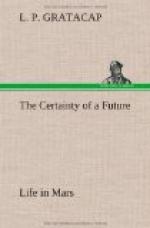But the most surprising phenomenon pertaining to the canals of Mars is their germination, which seems to occur principally in the months which precede and in those which follow the great northern inundation—at about the times of the equinoxes. In consequence of a rapid process, which certainly lasts at most a few days, or even perhaps, only a few hours, and of which it has not yet been possible to determine the particulars with certainty, a given canal changes its appearance and is found transformed through all its length into two lines or uniform stripes more or less parallel to one another, and which run straight and equal with the exact geometrical precision of the two rails of a railroad. But this exact course is the only point of resemblance with the rails, because in dimensions there is no comparison possible, as it is easy to imagine. These two lines follow very nearly the direction of the original canal and end in the place where it ended. One of these is often superposed as exactly as possible upon the former line, the other being drawn anew; but in this case the original line loses all the small irregularities and curvature that it may have originally possessed. But it also happens that both the lines may occupy opposite sides of the’ former canal and be located upon entirely new ground. The distance between the two lines differs in different germinations and varies from 600 kilometers (360 miles) and more down to the smallest limit at which two lines may appear separated in large visual telescopes—less than at intervals of 50 kilometers (30 miles). The breadth of the stripes themselves may range from the limit of visibility, which we may suppose to be 30 kilometers (18 miles), up to more than 100 kilometers (60 miles). The color of the two lines varies from black to a light red, which can hardly be distinguished from the general yellow background of the continental surface. The space between is for the most part yellow, but in many cases appears whitish. The gemination is not necessarily confined only to the canals, but tends to be produced also in the lakes. Often one of these is seen transformed into two short, broad, dark lines parallel to one another and traversed by a yellow line. In these cases the gemination is naturally short and does not exceed the limits of the original lake.
The gemination is not shown by all at the same time, but when the season is at hand it begins to be produced here and there, in an isolated, irregular manner, or at least without any easily recognizable order. In many canals (such as the Nilosyrtis, for example), the gemination is lacking entirely, or is scarcely visible. After having lasted for some months, the markings fade out gradually and disappear until another season equally favorable for their formation. Thus it happens that in certain other seasons (especially near the southern solstice of the planet) few are seen, or even none at all. In different oppositions the gemination of the same canal may present different




